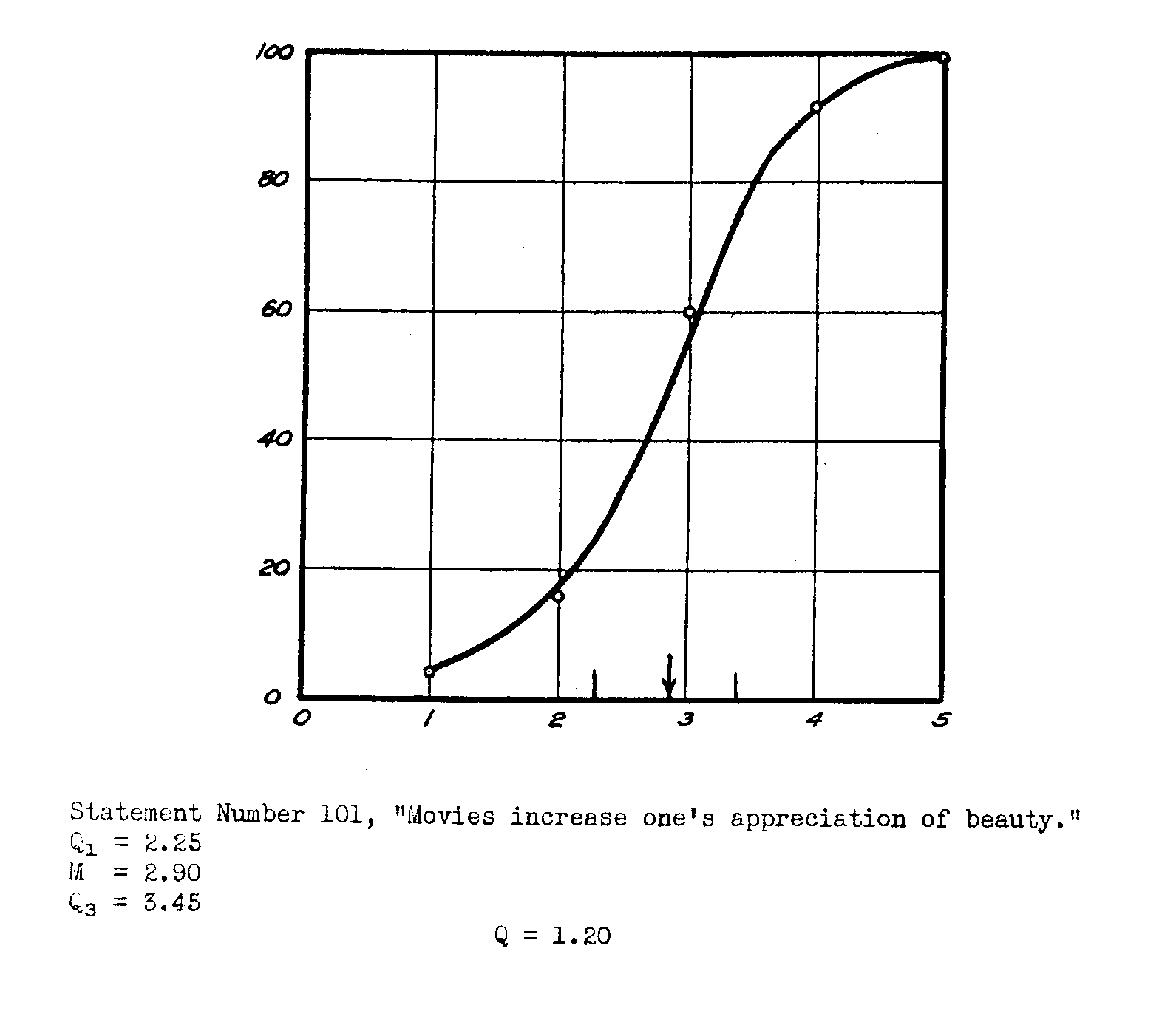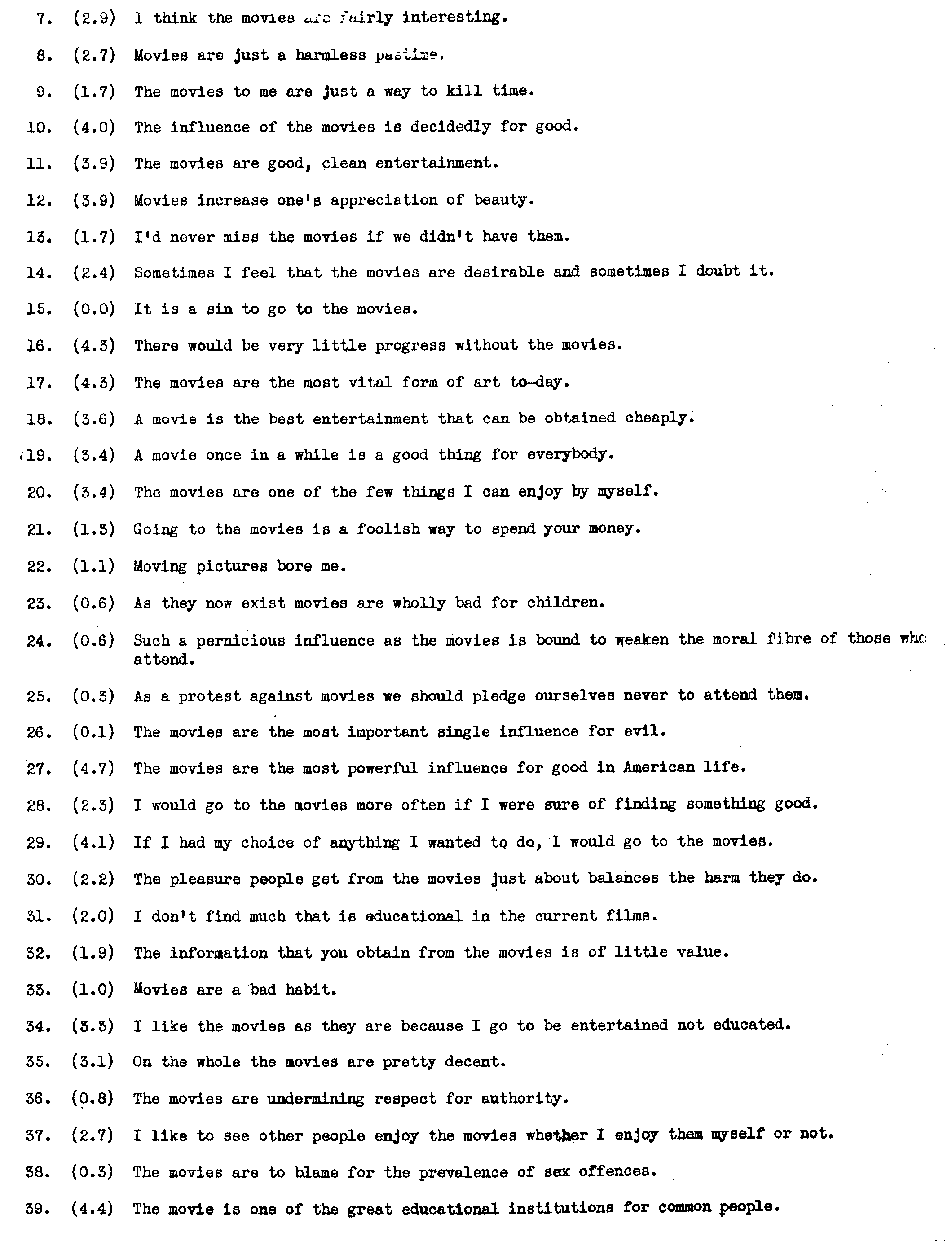The Effect of Motion Pictures on the Social Attitudes of High School Children
Chapter 6
Ruth C. Peterson and L. L. Thurstone
Table of Contents | Previous
One of the projects undertaken wee the construction of a scale of attitude toward the "movies". We wish to present this scale and to describe the method of its construction.[1]
The original collection of opinions about the movies consisted of two hundred and fifty-eight statements. These opinions, each of which reflects an attitude toward the movies, vary from statements decidedly in favor of the movies through neutral statements to those very much opposed to the movies. They were obtained from literature on the subject, from conversation, and from direct questioning of subjects whose education and experience varied from that of seventh grade children to that of graduate students in the University.[2]
Each statement was then typewritten on a separate card. As a preliminary method of eliminating the most unsatisfactory and retaining the best statements, as well as to get an approximate idea of the scale values of the statements, the method of equal-appearing intervals[3] was used with a small group of sorters. Twenty-five people, who had some understanding of the method being used and who were carefully chosen to make sure that the directions would be thoroughly understood and complied with, sorted the cards into eleven piles according to the following instructions:
"These cards contain statements about the value of the movies. Please arrange these cards in eleven piles so that those expressing attitudes most strongly in favor of the movies are in pile one, those which ere neutral are in pile six, and those which are most strongly against the movies are in the eleventh pile. The intermediate piles should represent steps in appreciation or depreciation of the movies.
"Do not try to get the same number of cards in each pile. They are not evenly distributed.
"The numbers on the cards are code numbers and have nothing to do with the arrangement in.piles.
( 65)
"You will find it easier to sort them if you look over a number of the slips, chosen at random, before you begin to sort."
The results of these twenty-five sortings were tabulated to show in which piles each statement was placed by the group of sorters. The scale values were then determined graphically. As an example of the method used one of the graphs is reproduced below.

The figure represents statement number 101 of the original group which happens to be retained in the final scale as Number 12. The graph shows that all the sorters classified the statement as favorable to the movies. The statement reads "Movies increase one's appreciation of beauty." The curve crosses the 50 percent level at the value of 2.9. This scale value is such that half the readers classified it as favorable to movies and half of them as less favorable.
The scale value is indicated by the arrow head on the base line. The lighter lines on either side of the arrow head indicate the quartile range of values assigned to the statements. The Q-value in this case is 1.10. This is a measure of the ambiguity of the statement.
For the application of a more exact scaling technique one hundred statements were chosen from the two hundred and fifty-eight. The choice was based on the following criteria:
(1) A continuity of scale values, i. e., a selection of approximately the same number from
( 66) each region of the scale.
(2) Selection of statements with small Q-values. .
(3) Diction and clearness of the statement itself.
The average Q-value of the statements retained was 1.18 with a range of .40 to 1.90; while the average Q-value of those. statements not retained was 1.44 with a range of .50 to 3.25.
Two hundred sets of these one hundred statements were then printed on three by five cards.
The one hundred statements were then arranged in ten envelopes for rank order sortings. The first envelope contained the fifteen statements most strongly in favor of the movies as determined 1)7 the preliminary scaling method. The second envelope contained statements 8 to 22, the third envelope 18 to 32, and so on, the tenth envelope containing statements 86 to 100. Thus it is seen that fifty of the one hundred statements were repeated in. two envelopes.
The statements in each envelope were in random order and the envelopes were also put in random order. The ten envelopes of statements were presented to the people who were to sort them with the following directions:
"Each envelope in this series contains fifteen cards. On each card is a statement about the movies. Some of these statements are in favor of the movies, and some of them ere against the movies. Will you arrange the fifteen statements in each envelope so that the statement which is most in favor of the movies is on top, face up, and the statement which is least in favor of the movies or most strongly against the movies is on the bottom. The cards should all be arranged so that each card is more in favor of the movies than the card under it and less in favor of the movies than the card above it.
"In considering each statement ask yourself this question:
"How strongly in favor of the movies is a person who endorsee or agrees with this statement?'
Try to disregard your own attitude toward the statements.
"The identification numbers on the cards have no significance."
Two hundred people sorted the statements by the above directions, putting the fifteen statements in each envelope in rank order.
The results of these sortings were tabulated, and from the tabulations we determined the proportion of times each statement was rated as more strongly in favor of the movies than every other statement. From these proportions the scale separations of the statements in each envelope were determined from the formula[4]
( 67)

in which (b - a) is the scale separation between a and b.
Χka is the deviation (k - a) in terms of the standard deviation. It is ascertained from the probability tables by means of the observed proportions K > a.
Xkb is the deviation (k - b) in terms of the standard deviation.
n is the number of statements minus one.
Since there were overlapping statements in each adjacent pair of envelopes, the scale separations for the whole set of one hundred statements could be calculated. The final scale values of the one hundred statements ranged from 4.74, the most strongly in favor of the movies, to 0.00, the most strongly against the movies. .
The one hundred statements were then divided into ten groups, with a range of .5 scale step in each group. Subsequently four statements were selected from each group, arriving at a final attitude scale consisting of forty statements approximately evenly spaced on the scale. The complete scale is given below, and the scale value of each statement is shown in parentheses following its serial number. The statements have been arranged in random order.

( 68)

( 69)
![]()
In scoring the attitude scale we cannot say that one score is better or worse than anοther; we can only say that one person's attitude toward the movies is more or less favorable than another person's. It is purely arbitrary that attitudes unfavorable to the movies have lower scale values than favorable attitudes.
Any individual's attitude is measured by the median scale value of all the statements he checks. The person who has the higher score is more favorably inclined toward the movies than the person with a lower score.
For the purpose of comparing groups, the distributions of attitude in each group can be plotted and it can then be said whether and how much one group is more favorable to the movies than another group.